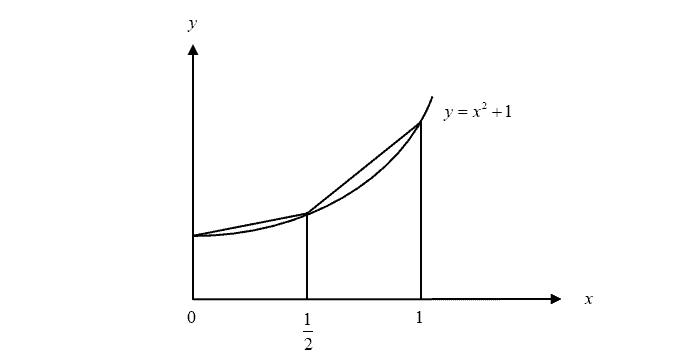2021 ASRJC P2 Q5
It is given that $R$ is the region bounded by the $x$-axis, the $y$-axis, the line $x=1$ and the curve $y={{x}^{2}}+1$.
The area of $R$ can be estimated by calculating the sum of the areas of trapeziums with equal widths. The diagram below (not drawn to scale) shows an example of two such trapeziums.
[Area of trapezium $=\frac{1}{2}\times $ sum of parallel sides $\times $ height]

(i)
Find the total area of the trapeziums shown in the diagram.
[2]
To better estimate the area of $R$, $n$ trapeziums of equal width are drawn.
(ii)
State the length of the shorter side of the ${{k}^{\text{th}}}$ trapezium for $1\le k\le n$. Hence show that its area is given by
$\frac{{{\left( k-1 \right)}^{2}}+{{k}^{2}}}{2{{n}^{3}}}+\frac{1}{n}$ units$^{2}$.
[3]
The sum of the areas of the n trapeziums is given as $A$ units$^{2}$.
(iii)
Find $A$, giving your answers in terms of $n$.
[4]
[You may use $\sum\limits_{r=1}^{n}{{{r}^{2}}=\frac{n\left( n+1 \right)\left( 2n+1 \right)}{6}}$]
(iv)
State whether $A$ is an overestimate or an underestimate of the area of region $R$.
[1]
(v)
Use your answer in part (iii) to find the exact area for region $R$.
[1]
Suggested Video Solutions
Our H2 Math Tuition includes
- Question Bank with Video solutions to 1400+ questions
- Online Portal
- H2 Math Summary Notes
- Structured Curriculum and Notes
Share with your friends!
Continue reading

Introducing Our Sec 1 Assessment Book: From Concepts to Confidence
Welcome to Tim Gan Math Learning Centre, where we have been dedicated to nurturing mathematical excellence since our establishment in 2017. At our centre, we are committed to providing quality

Entangled in the Web: Managing Online Entertainment, Internet Addiction, and Academic Achievement in Math
In today’s digital age, the internet has seamlessly woven itself into the fabric of our daily lives, becoming an indispensable tool for communication, information, and, notably, entertainment. The allure of

Goal Setting and Progress Tracking for Math Students: A Comprehensive Guide
In the pursuit of academic success, setting and achieving goals play a pivotal role, particularly in disciplines like mathematics. Effective goal setting not only provides students with a roadmap for
